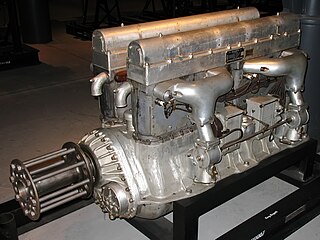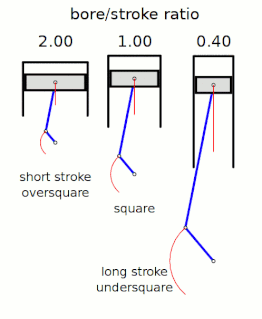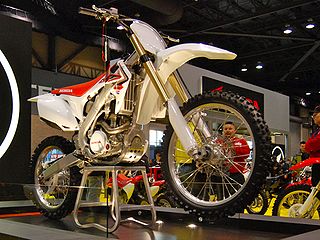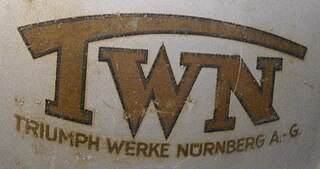
A flat-four or horizontally opposed-four is a flat engine with four cylinders arranged in two horizontal banks of two, each bank lying opposite the other, a crankcase between them.

A straight-twin engine, also known as straight-two, inline-twin, vertical-twin, or parallel-twin is a two-cylinder piston engine which has its cylinders arranged side by side and its pistons connected to a common crankshaft. Compared to V-twins and flat-twins, straight-twins are more compact, simpler, and usually cheaper to make, but may generate more vibration during operation.

The inline-four engine or straight-four engine is a type of inline internal combustion four-cylinder engine with all four cylinders mounted in a straight line, or plane along the crankcase. The single bank of cylinders may be oriented in either a vertical or an inclined plane with all the pistons driving a common crankshaft. Where it is inclined, it is sometimes called a slant-four. In a specification chart or when an abbreviation is used, an inline-four engine is listed either as I4 or L4.

A U engine is a piston engine made up of two separate straight engines joined by gears or chains. It is similar to the H engine which couples two flat engines. The design is also sometimes described as a "twin bank" or "double bank" engine, although these terms are sometimes used also to describe V engines.

A motorcycle engine is an engine that powers a motorcycle. Motorcycle engines are typically two-stroke or four-stroke internal combustion engines, but other engine types, such as Wankels and electric motors, have been used.

In a reciprocating piston engine, the stroke ratio, defined by either bore/stroke ratio or stroke/bore ratio, is a term to describe the ratio between cylinder bore diameter and piston stroke. This can be used for either an internal combustion engine, where the fuel is burned within the cylinders of the engine, or external combustion engine, such as a steam engine, where the combustion of the fuel takes place outside the working cylinders of the engine.

The Honda CL125 was a scrambler motorcycle made by Honda from 1967 to 1974. Two different engines were used through the models life: 1967-1969: CL125A 124cc 2 cylinder 4-stroke, 1973-1974: CL125S 122cc 1 cylinder 4-stroke.

The Honda NR was a V-four motorcycle series started by Honda in 1979 with the 500cc NR500 Grand Prix racer that used oval pistons. This was followed during the 1980s by a 750cc endurance racer version known as the NR750. The oval piston concept allowed for eight valves per cylinder which generated more power due to the increased air/fuel mixture throughput and compression. In 1992 Honda produced around 300 street versions of a 750cc model, the NR, with a 90-degree V angle. Whereas the NR500 had used an oval piston with straight sides, the road going NR750 used an elliptical piston with curved long sides. The bike became the most expensive production bike at the time when it was selling for $50,000 and with the rarity, nowadays they rarely change hands.

A single-cylinder engine is a piston engine with one cylinder. It is often used on motorcycles, scooters, go-karts, ATVs, radio-controlled vehicles, portable tools and garden machinery.

The Honda CRF series is a line of four-stroke motocross and trail motorcycles manufactured and marketed by Honda.

Garelli Motorcycles was an Italian moped and motorcycle manufacturer. It was founded in 1919 by Alberto Garelli.

Triumph-Werke Nürnberg AG or TWN, was a German bicycle and motorcycle company. In 1886, Siegfried Bettmann founded the Triumph bicycle factory in Coventry, England, and in 1896 he founded a second bicycle factory in his native Nuremberg, Germany, under the same Triumph name. Both factories branched out into making motorcycles: the Coventry factory in 1902 and the Nuremberg factory in 1903.

EMC Motorcycles or the Ehrlich Motor Co was a British motorcycle manufacturer. Based in Isleworth, the business was founded by Joseph Ehrlich who emigrated to the United Kingdom from Austria in the 1930s.
A big bang engine is an unconventional motorcycle engine designed so that most of the power strokes occur simultaneously or in close succession. This is achieved by changing the ignition timing, changing or re-timing the camshaft, and sometimes in combination with a change in crankpin angle. The goal is to change the power delivery characteristics of the engine. A regular firing multi-cylinder engine fires at approximately even intervals, giving a smooth-running engine. Because of a big bang engine's power delivery imbalance, there exists more vibration and stress in the engine. Thus, the power peaks are very strong and can overwhelm the rear tire, but when the rear tire does slide, the temporary lull in power between power strokes generally makes the slide easier to catch.

A desaxe engine, is one in which each cylinder is positioned with its exact center slightly offset from the center line of the crankshaft. "Désaxé", in French, means "unbalanced". Desaxe engines are usually automotive, but the term can also apply to steam engines.

The A7 Avenger was a 350 cc (21 cu in) Kawasaki motorcycle sold 1967 through 1971.



















